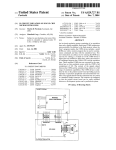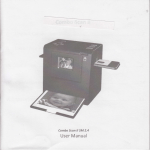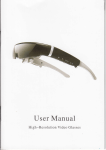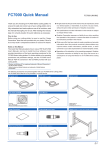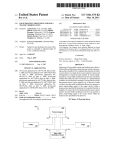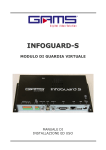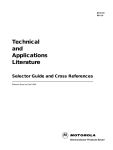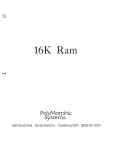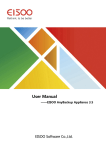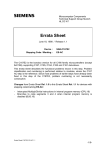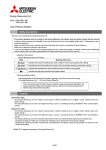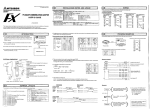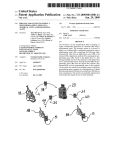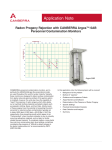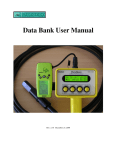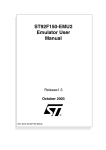Download Integrated circuit with embedded emulator and emulation system for
Transcript
US006230119B1 (12) United States Patent (10) Patent N0.: (45) Date of Patent: Mitchell http://WWW.mot.com/pub/SPS/DSP/LIBRARY/56100/FMi (54) INTEGRATED CIRCUIT WITH EMBEDDED EMULATOR AND EMULATION SYSTEM FOR USE WITH SUCH AN INTEGRATED CIRCUIT REVO/10.PDF, Oct. 1996* Motorola Digital Signal Processor Application Development System User’s Manual, Sections 1—5 [online], Motorola Corp., Aug. 13, 1997 [retrieved Aug. 9, 1999]. Retrieved from http://WWW.mot.com/pub/SPS/DSP/LIBRARY/ TOOLSDOC/ADS/DSPADSUMPDF, Aug. 1997.* “Ikos Grabs Emulation Firm, VMW”, Electronic Engineer ing Times, p. 1, Mar. 18, 1996.* (76) Inventor: Patrick Michael Mitchell, Carrigeeval, Ballyvalley, Killaloe, County Clare (IE) (*) Notice: Subject to any disclaimer, the term of this patent is extended or adjusted under 35 Babb et al., “Virtual Wires: Overcoming Pin Limitations in FPGA—based Logic Emulators”, Proc. IEEE Workshop on FPGAs for Custom Comp. Machines, pp. 142—151, Apr. USC 154(b) by 0 days. (21) Appl. No.: 09/019,789 (22) Filed: 1993* Babb et al., “Logic Emulation With Virtual Wires”, IEEE Trans. on Computer—Aided Design of Int. Circuits and Systems, vol. 16, Issue 6, pp. 609—626, Jun. 1997.* Dahl et al., “Emulation of the SPARCLE Microprocessor With the MIT Vritual Wires Emulation System”, Proc. IEEE Workshop FPGAs for Custom Comp. Machines, pp. 14—22, Apr. 1994.* Feb. 6, 1998 (51) Int. Cl.7 .................................................... .. G06F 9/455 (52) US. Cl. ............................... .. 703/27; 703/28; 714/30; (58) Field of Search ....................... .. 395/500.44, 500.48, 714/35 395/500.49, 183.06, 183.01; 703/23—25, 28; 203/25; 710/7; 714/30, 33—35 (56) US 6,230,119 B1 May 8,2001 Babb et al., “The RAW Benchmark Suite: Comuatation Structures for General Purpose Computing”, Proc. 5th Ann. IEEE Symp. on Field—PRogrammable Custom Computing Machines, pp. 134—143, Apr. 1997.* References Cited U.S. PATENT DOCUMENTS * cited by examiner 4,272,760 * 6/1981 PraZak et al. ...................... .. 341/120 PaWloski 5,313,618 * 5/1994 5,375,228 * 12/1994 ....... Leary et al. . . . . .. 703/28 . . . .. 714/33 ...... 5,467,200 * 11/1995 Ohsawa et al. 5,488,688 * 5,752,077 * 5,758,059 Primary Examiner—Kevin J. Teska Assistant Examiner—Douglas W. Sergent (74) Attorney, Agent, or Firm—Wolf, Green?eld & Sacks, 358/426 1/1996 Gonzales et al. . 5/1998 Yiu et a1. ........ .. .. 714/34 710/7 * 5/1998 Alexander 5,872,954 * 2/1999 Matsushita ..... . . . . .. 5,898,862 * 4/1999 Vajapey ................................ .. 703/28 PC. (57) 714/30 ABSTRACT .... .. 703/23 A data processor is provided in Which an embedded emu lator communicates With a control emulation system using a OTHER PUBLICATIONS serial communications link involving one pin of the data processor package. Motorola DSP56100 Technical Data, Section 10, On—Chip Emulation (OnCE) [online], Motorola Corp., Oct. 7, 1996 [retrieved Aug. 10, 1999]. Retrieved from the internet at 30 Claims, 7 Drawing Sheets Program Memory 52 lnstructlon Decoder EA Step Break Pin single points Interrupt Emulation Request Req uest Next Program Program V Address Address Controller 2K8 Boot EEPROM 8KB Code Flash EEPROM 54 t EMU REG j 5b U.S. Patent May 8,2001 Sheet 1 0f 7 US 6,230,119 B1 Prior Art Microcontroller Emulator Emulator GUI Emuloting System l \ Ergwslotion 17 Customer's 2 Fig 1 Target Board Emulator GUI Some Build in Chip used for Emulotion Customer's Target Board U.S. Patent May 8,2001 Emma" Sheet 2 0f 7 US 6,230,119 B1 NB User Does Not During Emulation Requests see lnternol Emulotion The Internal Emulation Memory Memory is Activated <- F900 [\,,\|2K l\ § <- F900 User _) Mode Q: Interface Q: Q: Q" \~ Internal tFFF 1'’ '-l :\\‘/ H- I ‘ User _> VIE-Tr J Mode ‘ Emulotor GUI lFFF 5%,’ L: '_‘_I. Interface Q ;‘_'l I 0000 ‘ 0000 42 40 \/ tttt 30 / EA Step Pin Single Breokpoints ln'fel'up’f R est t t V43 Emulotion Re est eq“ qu ;|' ./ 32 / 24 2KB BOOT Next Program Program —> Address Address 2o / EEPROM Controller 22 r 8K5 Code Flosh f EEPROM 28 Fig. 4 / 20 U.S. Patent May 8,2001 Sheet 3 0f 7 US 6,230,119 B1 53 Program 5211 / l nrr Tin lsuco Decoder EA S’rep Break Pin single poin’rs 'merrupl Request Emula’rion Request 2KB Boor EEPROM Nex’r Program Program —) Address Address J 32 Con’rroller 8K5 Code‘ Flash EEPROM ALU 1 EMU REG Fig. 5 r 56 50 _/ U.S. Patent May 8,2001 Sheet 6 0f 7 US 6,230,119 B1 EMUCON Register (EMUCON) CLKD 0 R/W EE EES ESS EAIN EAOUT O O 1 0 0 O 1 R/W R/W R/W R/W R/W R R/W U.S. Patent May 8,2001 Sheet 7 0f 7 US 6,230,119 B1 lI-. Galvanic Isolo?on gvcc COM MS IGND TARGET DATA PROCESSOR Fig. 9 US 6,230,119 B1 1 2 INTEGRATED CIRCUIT WITH EMBEDDED EMULATOR AND EMULATION SYSTEM FOR USE WITH SUCH AN INTEGRATED CIRCUIT troller for causing the data processor to enter an emulation mode, and dedicated registers for use in the emulation mode. It is thus possible to provide a softWare driven emulator Within a data processor Which leaves the registers used by the data processor to execute tasks unaltered during an TECHNICAL FIELD The present invention relates to an integrated circuit having an emulator embedded therein, and to an emulation system for use With such an integrated circuit. 10 BACKGROUND OF THE INVENTION Executable code for a data processor such as a microcontroller, requires testing and correction during its development cycle. SoftWare debugging is initially done in 15 a simulator or debugger offline. Once the softWare is debugged, it is then doWn loaded into the target system. HoWever, if the softWare does not Work correctly, for example, due to a timing problem it is then necessary to do or other information such as the contents of a stack or memory can be output after executing a single instruction of the user’s programme. Additionally or alternatively, the emulation controller is responsive to a single byte instruc tion placed in the user code in order to initiate the emulation it is manipulating. It is knoWn to perform this be removing the target data processor and replacing it With a replica of the data processor Which can be probed or interrogated via an emulation pod. The replica data processor emulates the real tion a reserved non-volatile memory area Which is hidden from the use of the data processor. Preferably the emulation controller can operate in a single step mode Wherein the register status of the data processor, an “in circuit” examination of the softWare and the data that data processor and this process is called “in circuit emula emulation or debug operation. A softWare driven emulator is ?exible and alloWs, for practical purposes, for an unlimited number of break points to be implemented. Preferably the registers dedicated for use by a data pro cessing core (also knoWn as an arithmetic logic unit) of the data processor during emulation can only be altered during emulation. Advantageously a programme for controlling the opera tion of the data processing core during emulation is stored in 25 . Adisadvantage of knoWn “in circuit” emulators is that the additional sockets, clips, adaptors or pods can induce extra parasitic components into the target system Which alter its performance. This usually restricts the emulation to a sloW mode. The single byte instruction is, in general Written over another instruction in the user’s programme. In order to ensure that the user’s program performs as intended, the overWritten instruction is held in a special purpose register so that it is executed When the emulation mode is excited. Additionally or alternatively, the data processor may also be responsive to a signal on one of the data processor control speed in order to avoid timing problems introduced by the parasitic components. The use of such in circuit emulators can cause problems Where debugging is to be performed in hybrid digital-analogue systems Where analogue accuracy is a critical issue, especially When more than 6 or 7 bit 35 resolution of analogue variables is used. It Was also knoWn, in the case of microcontrollers Where the internal address and data busses do not come out to the pins in order to initiate the emulation mode. According to a second aspect of the present invention, there is provided a data processor having an emulator embedded therein, and in Which the emulator is initiated by a single Work instruction. According to a further aspect of the present invention, there is provided a data processor including an emulator therein arranged to communicate information concerning pins of the data processor, to produce a special “bond-out” the internal status of the data processor via a serial commu version of the circuit. This has to be manufactured into a nication link. Preferably the serial data link utilises a pin in the data bigger package to bring these extra signals to the pins so that the emulator can monitor them. The bond-out version is processor package. Advantageously the pin is multiplexed disadvantageous since it requires the chip manufacturer to create a second version of the chip and package, With consequent timing differences from the read chip, increases 45 complexity, and a need to provide an adaptor for connecting the “bond-out” version of the chip to target systems in place is to initially execute instructions from an internal or an of the standard chip package. external memory. Once this information has been conveyed to the processing core of the data processor the pin becomes effectively redundant. Such a pin may then be used as a communication link betWeen the embedded emulation sys tem Within the data processor and an external development It is knoWn to integrate emulation address comparators and emulation break point registers Within an integrated circuit and then to perform a hardWare compare of the contents of the address resister With the emulation break point register in order to determine When to force a break point for emulation purposes. HoWever, the additional reg system or emulator controller. 55 isters and comparators are Wasteful of space on the silicon die of the integrated circuit, and are in?exible in their operation. An additional register and comparator is required for each break point. Typically a designer may Wish to have betWeen eight and sixteen break points available. The addi tion of sixteen or so additional registers and comparators can add a signi?cant cost to the production cost of the integrated circuit. SUMMARY OF THE INVENTION According to a ?rst aspect of the present invention, there is provided a data processor including an emulation con With a control function of the data processor. For example, some data processors include control pins Which are only relevant during the poWer up initialisation of the data processor. The pin may indicate to the processor Whether it Preferably the emulator is responsive to a signal on the pin, such as a voltage transition, in order to activate the emulator. Preferably the emulator is a softWare controlled emulator, and comprises emulation instructions held as softWare Within a reserved memory integrated into the data processor. The receipt of the instruction to start emulation, either by a signal on the emulator control pin or via a softWare instruc tion Within the softWare being debugged, forces the data 65 processing core of the data processor to suspend execution of the user’s programming code and to execute instructions from the emulation instruction code. Preferably the receipt of an instruction to commence emulation causes a high level US 6,230,119 B1 3 4 non maskable interrupt to be issued to the data processing BRIEF DESCRIPTION OF THE DRAWINGS core of the data processor. The present invention Will further be described, by Way of example, With reference to the accompanying draWings, in Preferably the data processor executes emulation instruc tions using reserved emulation registers, thereby leaving the unaltered, except possibly for the programmed address con Which: FIG. 1 schematically illustrates a prior art emulator troller and the stack Which may experience some minor and arrangement; Wholly reversible alterations. Advantageously an auxiliary FIG. 2 schematically illustrates an emulator constituting an embodiment of the present invention; FIGS. 3a and 3b schematically illustrate the memory organisation Within a data processor constituting an embodi ment of the present invention in normal operation and in contents of the registers used for programme code execution stack and/or auxiliary programme address counters may also be provided solely for use Within the emulation routine such that the registers, programme counter and stack used by user executable code may be left entirely unaltered. As an alter 10 native dedicated registers may also be provided for storing emulation mode, respectively; the contents of the program address controller In yet a further alternative, the data processor may be arranged to doWn load the stack and register contents to virtual registers 15 FIG. 4 schematically illustrates the internal layout of a microcontroller constituting an embodiment of the present With an emulator control data processor or Within an inter invention; face element, and to up load the register and stack contents When exiting the emulation mode. According to a further aspect of the present invention, there is provided a development system comprising a control data processor for monitoring the status of a target data FIG. 5 schematically illustrates the internal layout of a microcontroller constituting a further embodiment of the present invention; FIG. 6a to 6d schematically an emulation in a single step mode; processor, Wherein the target data processor includes an embedded emulator for communicating information con cerning the internal status of the target data processor via a serial communications link, the development system includ ing interface element adapted to communicate via the serial FIG. 7 schematically illustrates an emulation using a single step break point instruction; 25 FIG. 8 shoWs a layout of a special purpose emulation register; and communications link. The interface element may be in the form of a pod FIG. 9 schematically illustrates the emulation system. providing electrical isolation betWeen the target and control DESCRIPTION OF THE PREFERRED EMBODIMENT data processor. Advantageously the pod provides bi-directional communication betWeen the target and control data processors and includes a controllable voltage generator for causing a voltage transient on an emulation control pin of the target data processor for forcing it to enter the emulation mode. The voltage generator may also be used to communicate data and instructions to the target data pro FIG. 1 schematically illustrates a prior art emulator in Which a large emulation pod plugs into the data processor 35 package Which typically displays register contents of the cessor. target processor and alloWs for editing of instructions via a graphical user interface (GUI). The large siZe of the emu lation pod makes it inconvenient to use and also can give rise to subtle changes in operation of the target board due to the extra load and parasitic components introduced by the emulation pod. Furthermore, the knoWn emulation pod uses Advantageously the interface element communicates With the control data processor via a conductive link, such as a cable. Alternatively, the communications pod may commu nicate With the control data processor over a radio or optical based, such as infra-red, communications link. Advanta geously the or each communications pod has a unique identity such that a plurality of pods may be independently addressed by a single emulation control data processor. Thus a different or modi?ed data processor Which gives rise to 45 the emulation control data processor can control and/or As shoWn in FIG. 2, an emulation system comprising a system. data processor constituting and embodiment of the present invention and an interface card 3 for providing galvanic Advantageously the or each interface element contains a local data processor for handling may timing features or handshaking required to communicate over the data link. The local data processor may contain registers or memory for temporarily storing the register contents of an associated isolation betWeen the customer’s target board and the emu lation control data processor 2 provides for a more compact target data processor, or may handle the modi?cation of a 55 block user program code, i.e. changing the code or inserting a break point instruction. In a preferred embodiment, the or each interface element is a pod having three pins, one for connection to ground, one for connection to the poWer rail Vcc, and one for connection to the pin on the target data processor for communication thereWith. emulation system and, more importantly does not change the operating characteristics of the customer’s target board due to the introduction of parasitic components. The data processor having an emulator according to the present invention performs emulation under softWare con trol. In order to achieve this a reserved memory containing emulation instructions is provided as an integral part of the data processor. As shoWn in FIG. 3a, a data processor may have, for example, a memory space in Which addresses 0000H to lFFFH (Where “H” indicates that the addresses are expressed in hexadecimal) are provided for internal user It is thus possible to integrate emulation and debug As used herein, “emulation” includes softWare debugging carried out using the target processor. changes in output driving characteristics and loadings Which can effect signal timings and degrade analogue performance Where analogue circuits or DAC or ADC’s are involved. debug a plurality of target data processors Within a target features With a data processor, thereby ensuring that emu lation has minimal effect on the operation of the target board. socket on a customer’s target board in order to provide interconnection With an emulator system comprising an emulation control processor running an emulator softWare 65 programme code and the addresses 2000H to FFFFH are allocated to external user code space. The emulation memory is placed on another page of memory such that it remains hidden from the user. Thus, for example, external US 6,230,119 B1 5 6 memory addresses F900H to FFFFH may contain a user programme, Whereas internal addresses F900H and above contain the emulation programme. processor to be disabled if the correct code, in this example 101, is Written into these bits of this function register. This enables the emulator to halt internal timers and interrupts FIG. 4 schematically illustrates the internal arrangement When executing an emulation function. The fourth bit is an emulation enable bit, EE, Which is placed in the enable of a data processor, generally illustrated as 20, Whereby a programme address controller 22 holds the address of the condition by default and enables emulation to be started When an appropriate emulation request is received by the emulation request controller. The ?fth bit enables execution of the contents of the special function register EMU2. When next memory location to be read from. This location nor mally points to a boot strap memory 24 Which contains executable code to be used during poWer up sequences or for data exchange routines, or to a user programme 26 Which may be stored in an internal user code memory 28 or in 10 external memory (not shoWn). The programme address controller 22 is responsive to an interrupt request handler 30 Which, as is Well knoWn in the art, alloWs normal execution of a programme to be interrupted in order to respond in a 15 an emulation routine is started by the occurrence of the emulation break point in the user programme code, this EES register is inspected in order to determine Whether the break point instruction should actually be executed. If the contents of this register are not set, then the emulation Will be performed. When the emulation routine is completed, the address pointer points to the address of the break point. As predetermined Way to speci?c events. The data processor is mentioned earlier, the original instruction Which Was over arranged to execute an interrupt routine in response to an interrupt request and then to return to the user code When the Written by the break point is loaded into the EMU2 special interrupt routine has been completed. The data processor programme returns control to user code, it sets the EES bit. The address programme counter Will return control at the function register and the bit EES is cleared. As the emulation constituting an embodiment of the present invention is also provided With an emulation request controller 32 Which issues a priority non-maskable interrupt request Which takes precedence over all other interrupt functions. The interrupt controller 30 is arranged to buffer incoming interrupts While the programme address controller is responsive to the emu lation request controller 32 in order to ensure that interrupt requests are properly serviced upon return from the emula tion mode. 25 the EMU2 register is executed, thereby ensuring that the next occurrence of the break point instruction Will cause the emulation routine to be re-entered. The sixth bit is an emulation single step, ESS bit Which causes the data processor to only execute single instructions The emulation request controller is responsive to three inputs. A ?rst input 40 is responsive to a voltage transition on a single pin of the data processor package. In the preferred embodiment, the pin is a “EA” pin (provided on all ADuC812 data processor) Which is used to tell the data betWeen emulator programme operations. The ?nal tWo bits EA-in and EA-out enable the status of processor and it should execute from internal (EA=high) or external (EA=loW) memory during the poWer up. The state of the pin is latched by the data processor at poWer up or address of the break point instruction. HoWever, this time the EES bit is set and instead of re-executing the emulation routine, the processing core of the data processor is caused to execute the instruction held in the EMU2 special function register. The EES bit is then toggled once the instruction in 35 the EA pint to be read and Written to respectively. FIGS. 6a to 6d schematically illustrate operation of the emulator in a single step code execution mode. The emula tion routine takes advantage of the fact that the emulation interrupt Will not respond until at least one instruction of the reset and thereafter it can be used as the emulation control user code has been executed. Thus once control has been pin. The EA pin is also used, When emulation has been passed from the emulator to the user code, the emulator issues, via a hardWare resource, a highest priority non maskable interrupt that ensures that programme execution is initiated, as a bi-directional serial communications pin. The emulation request controller is also responsive to a single step ?ag 42 Which ensures that an emulation request immediately returned to the emulator, irrespective of What instruction Was being performed. occurs after execution of a single instruction of the user programme code. Preferably, the emulation controller 32 is responsive to a break point instruction 43 Whose occurrence in the user code causes the emulation controller 32 to issue an emulation request. 45 Thus as shoWn in FIG. 6a, the emulation control data processor is arranged to issue an emulation request via the EA pin Which causes a jump to the emulation memory. This initially alloWs communication betWeen the emulation con trol data processor 2 and the emulator in order that neW As shoWn in FIG. 5, a break point instruction decoder 50 is provided to speci?cally handle the occurrence of the instructions can be set in the emulator, such as changing one additional single byte emulation instruction (break point example, the control data processor sets the single step instruction, ESS, ?ag in the EMUCON register. Once the or more of the ?ags in the EMUCON register, in this instruction) contained Within user programme memory 52, Which may be external memory or, more likely, internal memory area 28. Additionally, a special register EMU2 53 is provided to hold the instruction Which Was overWritten by the emulation request instruction thereby ensuring that the 55 addresses of the remaining programme code are unaltered. As shoWn in FIG. 5, the processing core 54 (also knoWn as an arithmetic logic unit ALU) has a dedicated set of reserved With the single step enabled, and interrupt request is issued via the emulation controller 32 thereby causing control to be registers 56, EMUCON, EMUl and EMU2, for using during emulation. The reserved register set may also include an alternative stack and/or programme counter for use during emulation. FIG. 8 illustrates the emulation control register, EMUCON, provided Within a data processor including an embedded softWare controlled emulator. Workings from the left to right, the ?rst three bits of the register form a control Word Which causes internal timers and clocks of the data emulation control data processor has indicated that it does not Wish to set any further instruction changes, control is relinquished from the emulation code and the user code is executed. HoWever, since the EMUCON register Was set 65 returned to the emulation code after a single instruction of the user code has been executed as shoWn in FIG. 6c. The emulation code then doWn loads data to the emulation control data processor 2 via the EA pin. DoWn loaded data may include the status of the internal registers of the data processor, but may also, depending on instructions received from the emulation control data processor, include the contents of the stack and also the contents of selected areas internal or external memory, or the contents of an internal cache. US 6,230,119 B1 8 7 FIG. 7 illustrates an example of an emulation request the data has been sent to the emulation data processor, the emulation data processor toggles the EES bit and issues a initiated via the break point instruction. command causing the emulation to continue. The emulator The data processor has a data processing core supporting the 8051 instruction set. The 8051 instruction set has a then returns control to the user programme. Because the unused instruction code of A5. The A5 instruction has been break point instruction is interrupt driven, the control is implemented as the break point instruction. returned to address 0120 Which holds the A5 break point instruction. This time the EES bit indicates that emulation should not be recommenced, but in fact that the instruction in the EMU2 register should be executed. The data process ing core executes the instruction in the EMU2 register and It is knoWn to initiate a softWare emulation or debug by including a jump instruction to the emulation code. HoWever there is a signi?cant problem With this approach since the jump instruction is a 3 byte instruction and if this Was inserted at address 0120, as shoWn in FIG. 7 then the inc A and DAA instructions at addresses 0121 and 0122, 10 returns control to the user programme at the address fol loWing the break point instruction. FIG. 9 schematically illustrates a multi-target develop respectively, Would be overWritten by the jump instruction. Thus it Would be necessary to change the addresses of the subsequent steps in order to incorporate the addition of this jump driven emulation instruction. Secondly, in order to use this approach, the emulation memory/programme must be visible for the jump to Work and consequently the incorpo 15 ration of the emulation code Within the data processor Would limit the user’s programming options. A third problem is 20 that, if the addresses of all the remaining code Was not changed, it Would result in the instructions at 0121 and 0122 being lost, and also an additional break point could not be inserted at the overWritten addresses. By adding a single byte break point instruction, only one ment system in Which a single control data processor 2 communicates With a plurality of target data processors via a plurality of interface elements 3, each of Which contain a local data processor 100 Which reduces the computational load on the control data processor by performing the com munications protocols and also buffers and modi?ed data in the target data processors in response to commands from the emulation control data processor 2. It is thus possible to provide a data processor having a softWare driven emulator embedded therein Which uses 25 dedicated registers, thereby ensuring that registers used in execution of a user’s programme do not become altered once address of programme is over Written. Thus in the example in FIG. 7 only the “clear A” instruction at 0120 is overWrit ten by the inclusion of the softWare driven emulation break the emulation mode is commenced. It is also possible to provide a development system for use With such a micro as if the break point instruction Were not there. If a break processor in order that the internal registers may be inspected, or blocks of memory may be inspected and analysis performed thereon. For example, a block of point instruction is to be Written into the user code for debugging/development purposes, the emulator reads out a memory may hold values resulting from analogue to digital conversions. The values may be displayed by the emulation point instruction. HoWever, the clear A instruction is Written into the EMU2 register in order to ensure that it is executed 30 control data processor in order to form an oscilloscope trace block of memory containing the program code containing the address of the instruction to be changed. An internal 35 memory controller then erases the block of memory, and in co-operation With the emulation control data processor, re-programs the block of memory adding the break point instruction. The precise memory control strategies for per forming the modi?cation of internal memory Within the data processor, ie within a single chip package, are not critical 40 to the present invention, but a suitable memory and memory controller is described Within a co-pending application ?led by Analog Devices, and titled “A MEMORY AND A DATE PROCESSOR INCLUDING A MEMORY”. The interface element 3 may provide a local buffer such that as the block 45 The emulator has authority to modify the internal memory re-programmed Whilst it is in situ in the target board. Similarly calibration coef?cients in digital or hybrid digital 55 analogue systems can be modi?ed. It is also possible, When the interface element communicates using a radiative link, to leave the interface element attached to the target board permanently, thereby alloWing for the target data processor to be re-programmed even after it has been installed in a Working environment. The provision of an emulator as an integral part of the target data processor has the additional 60 advantage that the board and processor being debugged/ developed are identical to the ?nal system. This contrasts EES bit is cleared, the data processing core executes the and outputs data concerning the status of the various pro gramme registers to the emulation data processor 2. Once emulator 2 may display a plurality of WindoWs, With each displaying the status of and/or controlling the function of a respective target data processor Within a multi-processor target board. Thus the operation of master and slave pro cessors may be analysed, possibly on a single step basis, in order to check their data exchange operations and mutual contents of program and data memory Within the target data processor. Thus the target data processor may be EES bit in the EMUCON register cleared. Assuming that the emulation instructions using the reserved EMU1 register, send these to the emulator control processor Which can then display a graph or trace of the converted variable. The performance. of program code (usually tWo roWs on the internal non volatile reprogrammable user code memory of the data processor), is buffered in the interface element and the local data processor modi?es the data to change instructions or insert the break point, and then re-presents the data to the target data processor in order that it can reWrite the data into in’s internal memory. During execution of the user programme, the programme counter Will eventually point to the address 0120 Which has the A5 emulation break point instruction Written therein in place of the “clear A” instruction. The instruction decoder of the data processor decodes the break point instruction and causes the emulation request controller 32 to issue a priority interrupt. Thus the data processing core 54 discontinues execution of the user’s programme and starts executing instructions from the emulation memory provided that the of the analogue value, or additionally or alternatively may be Fourier transformed in order to perform frequency domain analysis. The emulator may be used to perform a softWare controlled series of Analogue to Digital conversion, and to 65 With prior art emulators of the type shoWn in FIG. 1 Whereby the data processor on the emulation pod synthesises the functions of the target data processor but in often a physi cally different type of processor Which may have additional hardWare attached thereto to simulate the ports of the target data processor. US 6,230,119 B1 9 10 What is claimed is: 1. A data processor including an emulator, wherein the 16. A development system as claimed in claim 4, in Which the interface element automatically detects the data trans mission rate of an associated target data processor operating emulator is arranged to perform bi-directional communica tion With an external development system via only a single terminal. in an emulation mode. 2. A data processor as claimed in claim 1, in Which said single terminal is a control pin of said data processor, said the interface element performs handshaking and data eXchange With the target data processor. 17. A development system as claimed in claim 4, in Which pin only controlling said data processor during a predeter mined operation. 3. A data processor as claimed in claim 2, in Which said 18. A development system as claimed in claim 4, in Which 10 predetermined operation is an initialisation sequence. 4. A development system for use With a target data processor including an emulator, Wherein bi-directional communication betWeen said development system and the target data processor occurs via a serial data link utilising the interface element performs handshaking and data eXchange With the control data processor. 19. A development system as claimed in claim 4, in Which the interface element moves control and data information 15 only a single pin of the data processor, said development betWeen the target and control data processors. 20. A development system as claimed in claim 4, in Which the interface element communicates With the target data processor via a serial communications link. system comprising a control data processor and at least on interface element each providing an interface betWeen the control data processor and a respective target data processor. 21. A development system as claimed in claim 4, and arranged to communicate With a target data processor such that a program code stored in an EEPROM of the target data processor can be programmed in situ. 22. A development system as claimed in claim 4, in Which 5. A development system as claimed in claim 4, in Which said at least one interface element provides electrical isola tion betWeen the target data processor and the control data processor. the development system can modify programme instructions stored in an EEPROM Within the target data processor and 6. A development system as claimed in claim 4, in Which the at least one interface element contains means for causing 25 also modify data. 23. A development system as claimed in claim 22, a transition on the data link in order to cause the target data Wherein said data includes calibration coef?cients. 24. A development system as claimed in claim 4, Wherein processor to enter an emulation mode. 7. A development system as claimed in claim 6, in Which said transition causing means is controllable to transmit instructions to the target data processor. the development system interfaces simultaneously With a plurality of target data processors. 25. A development system as claimed in claim 4, Wherein the development system is arranged to retrieve data from at 8. A development system as claimed in claim 4, further comprising a plurality of interface elements, Wherein each interface element is individually addressable by the control least one target data processor and display the data in a graphical form. data processor. 9. A development system as claimed in claim 4, Wherein 35 bi-directional communication betWeen the at least one inter face element and the control data processor is via a radiative data link. 10. Adevelopment system as claimed in claim 9, in Which the radiative data link is an infra-red data link. 11. Adevelopment system as claimed in claim 4, Wherein the status and register contents of the registers of the target domain analysis of the data said target data processor being data processor used for program code execution are retrieved and stored during emulation. 12. A development system as claimed in claim 11, Wherein the status and register contents of the target data 45 data processor occurs via a serial data link utilising a only single pin of the target data processor. 13. A development system as claimed in claim 11, Wherein the status and register contents of the target data 29. A development system as claimed in claim 4, in Which the interface member is left permanently connected to the target data processor and communicates With the control processor are stored in an associated interface element. 14. A development system as claimed in claim 4, Wherein the development system is arranged to read a block of data processor via a radiative communications link. 30. An interface member as claimed in claim 28, in Which program code from an area of EEPROM Within the data break point instruction at a chosen location so as to over Write an instruction in the program code Without changing the length of the program code. a production version of the data processor and not a special emulation version. 28. An interface member for performing serial commu nication With a target data processor and for communicating With an emulation control data processor, said target data processor including an emulator, Wherein bi-directional communication betWeen said development system and the processor are returned to the target data processor before recommencing eXecution of a user program. processor, to modify the program code and to re-present the modi?ed code to the EEPROM of the target data processor. 15. A development system as claimed in claim 14, in Which the program code is modi?ed by the insertion of a 26. A development system as claimed in claim 25, Where in graphical form is an oscilloscope trace. 27. A development system as claimed in claim 4, Wherein the development system is arranged to retrieve data from the at least one target data processor and to perform frequency 55 the interface member includes local memory such that the interface member can read a block of program code form EEPROM of the target data processor, modify the contents of the block of program code and reWrite it to the target data processor.













